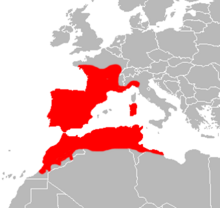Loading AI tools
Species of snake From Wikipedia, the free encyclopedia
The viperine water snake or viperine snake (Natrix maura) is a semiaquatic, fish-eating natricine water snake. Despite its common names, it is not a member of the subfamily Viperinae. It was given its common names due to exhibiting a dorsal colour pattern that superficially resembles that of sympatric adder species. In comparison to other Natrix species its head is also somewhat wider and more distinct from the neck. Like most members of the Natricinae it possesses a venom gland on each side of the upper jaw (Duvernoy's gland) that produces a mild venom that may play a role in swallowing or digestion. The gland is not associated with an enlarged specialized tooth and the venom has to be applied by chewing. The species usually does not bite as a means of defense, and the effect of a bite would be harmless to humans.
| Natrix maura | |
|---|---|
 | |
| Swimming, Spain | |
| Scientific classification | |
| Domain: | Eukaryota |
| Kingdom: | Animalia |
| Phylum: | Chordata |
| Class: | Reptilia |
| Order: | Squamata |
| Suborder: | Serpentes |
| Family: | Colubridae |
| Genus: | Natrix |
| Species: | N. maura |
| Binomial name | |
| Natrix maura | |
 | |
| Range map of Natrix maura | |
| Synonyms | |
The viperine snake looks like an adder and occasionally behaves like one. It is known to strike like an adder, but not to bite. It spends most of its time in water hunting fish, frogs and other aquatic animals. The species is diurnal.[2]
The viperine snake is found in southwestern Europe and northwestern Africa. Specifically, N. maura is found in the European countries of Portugal, Spain, Andorra, France, northwestern Italy, and Switzerland. It has spread to areas of England, as well[citation needed]. It is found in African countries of Morocco, northern Algeria, northwestern Libya, and northern to central Tunisia. It was introduced to Mallorca in the Baleares (not indicated on the distribution map).[2]
N. maura is grey, brown, or reddish dorsally, with a black zigzag vertebral stripe, and lateral series of black ocelli with yellow centers. The labials are yellow with black sutures. It has a diagonal dark band on each temple, and another behind it on each side of the neck. Ventrally, it is yellow or red, checkered with black, or all black. The strongly keeled dorsal scales are arranged in 21 rows. The ventrals are 147–160; the anal plate is divided; and the paired subcaudals number 47–72. Adults may attain a total length of 85 cm (33 inches), with a tail 17 cm (7 inches) long.[3]
The viperine snake is found in rivers and lakes, and has also been recorded from areas of brackish water.
The species is invasive on Mallorca.[4] N. maura predates on Pelophylax perezi among other prey on Mallorca. Research by Moore et al. 2004 suggests trophic subsidy provided by P. perezi is maintaining higher numbers of the invader than would otherwise occur.[4] N. maura has altered the behavior of Mallorcan prey. Moore et al. 2004 found that the higher numbers mentioned above are allowing the invader to exert such high pressure that prey species such as the Majorcan midwife toad (Alytes muletensis) have retreated entirely to habitats too steep for N. maura.[4]
Seamless Wikipedia browsing. On steroids.
Every time you click a link to Wikipedia, Wiktionary or Wikiquote in your browser's search results, it will show the modern Wikiwand interface.
Wikiwand extension is a five stars, simple, with minimum permission required to keep your browsing private, safe and transparent.